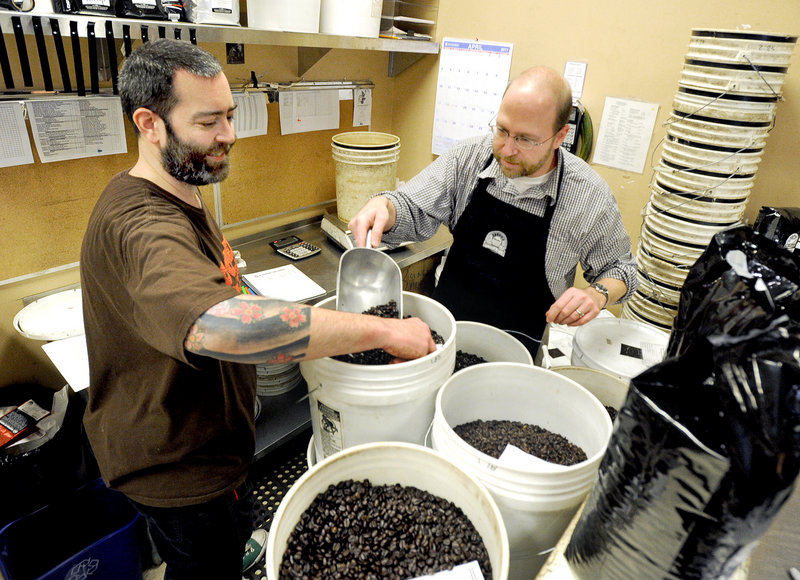PORTLAND – I’m used to seeing office cubicles full of papers or folders, but I had never seen one crammed with buckets of coffee beans before.
Not until I spent a morning helping Paul Chiles blend coffee beans at Coffee By Design on Washington Avenue, that is.
As a production worker at the Portland-based coffee roaster, one of his main jobs is to mix beans together in the proper proportions to form blends with such names as Casco Bay, Phileas Fogg and Rebel Blend. Then the blends are sold to retailers or used at one of the four Coffee By Design coffeehouse locations in southern Maine.
But before I could help blend the beans, I had to promise not to give away how much of which bean was used in each blend. Coffee is a competitive business, I’m told.
“These are recipes, really, and it’s just a matter of blending the flavors of the beans to get the flavor you want,” said Chiles, 40, of Portland. “Some beans have a nutty flavor; some Ethiopian beans have a blueberry taste.”
The beans in the buckets crowding Chiles’ work counter were from all over the world — South America, Africa, Indonesia. Chiles picked up a couple of handfuls to show me that not all beans are the same — some are smooth and some more coarse, depending on the tools used to extract them from the coffee cherry they grew in.
“Coffee cherry?” I asked.
“That’s what they grow in — a cherry,” Chiles told me.
I had another revelation when Chiles and I passed some buckets of beans that weren’t yet roasted and I saw they were green.
But the beans Chiles worked with were roasted in a 25-pound or 50-pound roasting machine, both just a few feet from the cubicle work areas where Chiles and two other production workers were blending and packaging coffee.
Someone else was doing the roasting — the head roaster, as a matter of fact. The hum of the roasters was constant as we worked, as was the aroma of the beans.
As Chiles began to plan out his blending agenda for the day, he showed me the recipes that specified the kind of bean, what kind of roast (French is dark; Italian is not as dark) and how much of each.
The first thing we did was lug a dozen or more buckets of beans weighing about 5 pounds each from a storage room over to Chiles’ work area. Each bucket had a ticket on the lid specifying the bean, the roast and the date it was roasted. (Most were roasted that day or the day before.)
I tried carrying four at a time, like Chiles, two in each arm. But navigating the narrow doorways was tough, and the plastic buckets kept slipping out of my arms.
When we got the buckets to the work area, Chiles took the covers off and laid the identifying tickets in each bucket. We began scooping and pouring beans from the buckets to make various blends.
Then it occurred to me — what if we lose a ticket amid all the commotion of working with a dozen kinds of beans? How will we know which beans are which?
“Well, we can go back to the (computer spreadsheet) and see what beans we roasted on what day, and how much,” said Chiles. “So if we had a bucket without a ticket, we could figure it out.”
The record-keeping for roasting and blending the beans at Coffee By Design is so detailed, they even keep track of the weather. That way they know if certain batches were roasted on humid days, dry days or days with low barometric pressure, all conditions that can affect the overall flavor of the beans.
Once we started making blends, Chiles wrote down the beans needed for each blend — some had as many as five, of various roasts — and the amount of each.
There was a standard recipe for each, but if Chiles was making a different amount than the recipe called for — say, 25 pounds instead of 5 pounds — he’d have to do some quick math, either in his head or on a calculator.
For one blend we were making, we needed 1.65 pounds of one bean, 1.35 pounds of another, and 1.05 of two others. When working with small amounts, I found that while weighing the beans I had to take out or add a few beans by hand to get the right amount.
Once we had everything weighed, we put the blended beans in another bucket attached to a spinning machine. Then we fastened a stretchy cord over the top and turned the spinner on for a minute or so. I thought I was following Chiles’ instructions perfectly, but I fastened the cord around the side of the bucket, not over the cover. If Chiles hadn’t corrected me, the blended beans would have poured out all over the floor.
“Spills do happen,” he said.
I learned that firsthand later, when I was helping another production worker, Charles Brant, package coffee in heat-sealed bags.
He showed me how to put the bag over a spout and fill the bags. Then he showed me a machine that took oxygen out of the coffee bags, put nitrogen in, and sealed them with heat.
All I had to do was put the bags on a little shelf, turn the machine on, then take the bags off. The machine that filled the bags was operated by a foot pedal, and at some point while he was showing me around, Brant stepped on the pedal with no bag in place. So beans went pouring onto the floor.
I was glad it wasn’t my fault, but it was definitely something I could have done, given a little more time.
“That’s not the first time that’s happened,” admitted Brant.
Staff Writer Ray Routhier can be contacted at 791-6454 or at:
rrouthier@pressherald.com
Send questions/comments to the editors.



